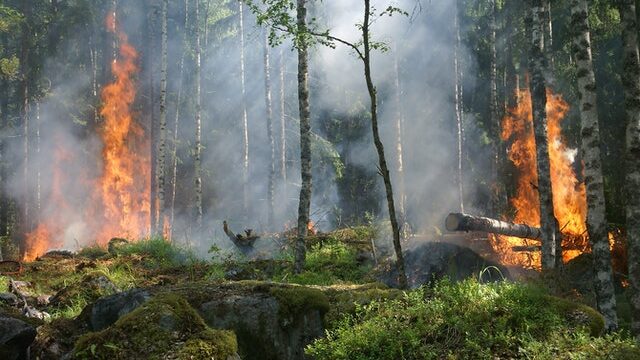Global Warming: Cause, Effect, and Ways of Prevention [PDF Included]
“Global Warming “–is a term that we commonly encounter today in our textbooks, news, debates, discussions, weather forecast as well as in our chats over a cup of tea. The term has become a hot topic today as global warming is no more a prediction but a happening that we all are experiencing and trying to understand together. However, despite relentless studies and research, it remains an abstract concept of science for the majority of the population. Here we shall try to understand how the phenomenon of global warming is so much more than a theoretical concept.
What you are going to learn?
Definition
Global warming is the phenomenon of a gradual increase in the earth’s average temperature generally due to the greenhouse effect caused by the increasing levels of hydrocarbons like carbon dioxide, chlorofluorocarbon as well as water vapor, and other pollutants.
The greenhouse effect occurs when the greenhouse gases like carbon dioxide, methane, nitrous oxide, chlorofluorocarbons, water vapor, etc., in the atmosphere absorb the radiations of the sun making the surface of the earth warmer. This phenomenon has made inhabitation possible on earth. However, the skyrocketing levels of these heat-trapping gases are having drastic effects like global warming, and becoming threats to lives.
Global Warming and Climate Change

Global warming and climate change are considered synonymous and are often used interchangeably. However, they are not the same absolutely and have distinct meanings. Global warming is the long-term heating of Earth’s climate system because of the increasing concentrations of heat-trapping greenhouse gases in the atmosphere. Whereas climate change is a long-term change in the average weather patterns such as precipitation, temperatures, and wind patterns that define Earth’s local, regional and global climates. Global warming and its effects on Earth’s weather patterns are just an aspect or a part of climate change.
Causes of Global Warming
Researchers claim to have observed global warming since the pre-industrial period of the mid-19th century due to several human activities, primarily the burning of fossil fuels. Although the records indicate a faster rise in the global temperature due to human activities, there are some natural forces also, such as forest fires, which contribute to global warming to some extent.
Here are some important natural and man-made causes of global warming.
Natural Causes
1. Forest Fires

Forest fires are one of the primary causes of global warming. The burning of the trees leads to the emission of carbon-filled smoke into the atmosphere. Along with carbon, detrimental gases like carbon dioxide and methane also escape into the atmosphere, polluting the air and raising the temperature. Forest fires cause natural deforestation which reduces the oxygen concentration in the air for a long span of time.
Forest fires and global warming create a cycle. Increased global emissions due to forest fires act in accelerating further global warming; global warming leads to extremely dry weather and fire-prone conditions which cause forest fires.
2. Permafrost
Permafrost is any frozen soil (0°C or below) that lasts for at least two years straight. It is most common in regions with higher altitudes (mountains) and higher latitudes (near the North and South Poles). The thawing of permafrost, triggered by warm weather conditions, contributes to global warming by releasing greenhouse gases into the atmosphere. When plants and animals die their remains end up in the soil. In freezing conditions, the soil microbes remain dormant and the undecomposed remains of the dead can be preserved for hundreds of years. With the availability of warmth, the soil microbes become active. They break down the dead organisms by converting the carbon in their body into carbon dioxide and methane.
Thus, the melting ice caps and snow-covered polar lands are causes of great concern as they are constantly leaking greenhouse gases into the earth’s atmosphere.
3. Sunspots and Solar Winds
Any changes or activities in the sun can affect the Earth directly. Several temporary hot and cold regions are found on the sun’s surface, which has an influence on the earth’s temperature. Sunspots are temporary dark regions on the sun’s surface with strong magnetic fields that cause solar flares and hot gassy ejections from the sun’s corona to the outward space. The solar flares, also known as solar winds, are a sudden explosion of energy that emanates from the sun. Solar winds consist of magnetized plasma flares, which influence galactic rays and may affect atmospheric phenomena on Earth, such as cloud cover.
Although sunspots and solar winds play a role in raising the global temperature, their effect is very minimal. Majority of the climate scientists agree that global warming is primarily caused by emissions from industrial activities.
4. Water Vapour
Water vapor is an effective greenhouse gas as it absorbs long-wave radiation and traps heat. It plays a key role in the feedback process. Warmer air can hold more moisture than cooler air. As air temperature increases, the rate of evaporation from water sources also increases, causing a rise in the water vapor content of the air. This process of increasing water vapor content in the atmosphere is known as the feedback process. The increased amount of water vapor in the atmosphere enhances the greenhouse effect and amplifies global warming.
5. Volcanoes

Volcanic eruptions emit large quantities of greenhouse gases like carbon dioxide, methane, and water vapor. Although the effect of these volcanic activities on global warming is very minimal, yet they play quite a noticeable role in climatic changes.
6. Other Living Beings
Like humans, other animals also breathe out carbon dioxide and release methane when their carbon-rich dead remain breakdown and decompose in the soil. However, the contribution of other animals is minuscule compared to humans in causing global warming. Although minor, still the role of the animal kingdom is counted as a natural cause of global warming.
Man-Made Causes
1. Fossil Fuels
The burning of fossil fuels, and the resultant pollution is the major contributor to global warming. The pollution may be caused by several factors such as vehicles, electricity production, and industries. In recent decades, the number of vehicles has increased, leading to a sharp rise in the number of fossil fuels that are burnt daily. A large number of greenhouse gases, along with other harmful gases are released into the atmosphere when fossil fuels are burnt. The emitted gases increase Earth’s average temperature.
To produce electricity and power, a large quantity of non-renewable fuels, especially coal, are burnt. The burning of coal produces around 1.7 times as much carbon dioxide as natural gas and 1.25 times as much as oil. Coal is responsible for over 0.3°C of the 1°C increase in the global average temperatures.
Industrial activities play the most significant role in amplifying global warming. Several harmful gases are released into the water as wastes by the industries. Increasing industries are adding more and more greenhouse gases as well as dust and other harmful particles to the atmosphere, causing air pollution. Oil also releases a high amount of carbon dioxide when burnt. We also find many cases of oil spills that have a devastating effect on the ocean’s ecosystem.
Natural gas is said to be cleaner fossil fuel. Yet burning of natural gas should be counted as a cause of global warming because carbon dioxide and other gases are emitted, though very less in quantity.
2. Deforestation
![Global Warming: Cause, Effect, and Ways of Prevention [PDF Included]](https://educationleaves.com/wp-content/uploads/2022/05/pexels-ivars-4324342-edited.jpg)
Cutting down trees and clearing forests by men to make way for any development activity and to house the booming population is called deforestation. It is obviously totally different from deforestation by nature through forest fires. Human-induced deforestation is profit-oriented, as a large variety of forest produce such as paper, timber, medicinal plants, and so on, are sold worldwide; clearing land by cutting down trees also provides more land to build new cities and towns.
However, the removal of forest cover creates a huge vacancy in the atmospheric oxygen concentration, which is essential for combating the rising amount of carbon dioxide. The concentration of carbon dioxide and nitrous oxide increases due to the lack of trees present to consume these gases. Thus, the abundance of greenhouse gases in the atmosphere and the removal of their combating agents is a potential cause of global warming. Moreover, the use of woods and charcoal as fuels only adds to the polluting gases in the atmosphere.
3. Agriculture
Agriculture is an enormous source of greenhouse gases, largely Agriculture methane and nitrous oxide, and is, therefore, a significant contributor to anthropogenic global warming. Methane and nitrous oxide are the major emissions of agriculture, a small amount of carbon dioxide is also emitted due to the application of urea and lime as fertilizers. However, major carbon dioxide emissions in the agricultural sector originate from the burning of fossil fuels used to power agricultural machinery. Methane is produced from the fermentative processes in manure used in cultivating crops. The livestock sector itself is highly responsible for human-induced methane emission, as the decomposition of animal excreta produces methane. But nitrous oxide is an indirect product of organic and mineral nitrogen fertilizers.
Artificial and synthetic fertilizers rich in nitrogen, pesticides, and herbicides can pollute soil and water, causing harm to the ecosystems. The use of fertilizers is one of the leading causes of global warming.
4. Over Population
![Global Warming: Cause, Effect, and Ways of Prevention [PDF Included]](https://educationleaves.com/wp-content/uploads/2022/05/pexels-lt-chan-2833373-edited.jpg)
The root of all the man-made causes of global warming extends to overpopulation. First of all, an increasing number of people means breathing out more carbon dioxide into the air and using up more oxygen from the air. More people means more demand for food, shelter, and other necessary things. More lands are to be cleared to provide them shelter and more plants are to be chopped off to provide plant produce, leading to deforestation. For food, more crops are to be yielded by adding more artificial fertilizers which can pollute soil and water. In order to transport the goods and services, more vehicles are to be employed, leading to more burning of fuels and more pollution in the air. More industries are built to provide jobs to the increasing mass of people. By now we know that increasing factories and firms is directly proportional to increasing global warming. Thus, overpopulation makes the existing problem of global warming all worse and no good.
5. Landfills
Landfills are the areas where big chunks of stinky garbage are collected in heaps. Later on the garbages are either recycled by big companies to make useful products or are burnt down. The garbages consist of several types of materials and burning them can release toxic gases like methane into the air. This, in turn, worsens global warming.
6. Mining
![Global Warming: Cause, Effect, and Ways of Prevention [PDF Included]](https://educationleaves.com/wp-content/uploads/2022/05/pexels-vlad-chetan-2892618-edited.jpg)
Oil, coal, and natural gases are obtained by mining. Although these elements serve our purposes, their overuse plays an active role in global warming.
Several types of harmful gases are also stored in the pockets under the ground. While mining these gases, including methane, carbon dioxide, and nitrous oxide are released into the atmosphere. The whole process of mining from extraction to transportation plays a vital role in global warming.
Effects of Global Warming
The devastating consequences and effects of global warming can be observed in real-time in many places. Let us have an in-depth discussion of these effects here.
1. Increase in Average Temperature
One of the foremost and obvious effects of global warming is the gradual increase in the average atmospheric temperature. According to the National Oceanic and Atmospheric Administration (NOAA), the average global temperature has increased by about 1.4°F or 0.8°C over the past 100 years. The existing dry regions are said to go drier because of the rising temperature. Scientists and researchers are fearing the genesis of decades-long “mega-droughts”, which can be harsher than anything else in human history.
The study conducted by Benjamin Cook, a climate scientist at NASA’s Goddard Institute for Space Studies in New York City, predicted an 85% chance of droughts that may last for at least 35 years in North America by 2100. The reason behind this mega draught is the increased evaporation of water and the loss of precipitation in the region. Many areas are likely to see less rainfall if global warming continues like this.
Drying forests and grasslands can experience devastating wildfires. According to National Interagency Fire Centre Data, a steady increase in the extent of wildfires has been seen since the 1980s.
2. Extreme Weather
An immediate effect of global warming is extreme weather. The higher atmospheric temperature warms up the oceans as well. Warm water causes more evaporation of moisture, which in turn becomes the driving force for intense storms like hurricanes and typhoons. “And even if they become less frequent globally, hurricanes could still become more frequent in some particular areas,” said atmospheric scientist Adam Sobel. He further says that “Additionally, scientists are confident that hurricanes will become more intense due to climate change”. This is because global warming increases the temperature difference between the warm tropical ocean and the cold upper atmosphere, and hurricanes gain their energy from this temperature difference.
Another extreme weather is colder-than-normal winters in some areas even during the long-term global warming. This happens as climatic changes cause the polar jet stream to migrate to the south from the North Pole, bringing with it the cold Arctic air.
Another weather feature that is highly affected by global warming in recent decades is lightning. Researchers have found a 12% increase in lightning for every 1.8°F or 1°C rise in the atmospheric temperature.
These extreme weather events, including heatwaves, droughts, blizzards, and rainstorms, are bound to occur more often and with greater intensity, if the trend of global warming continues in the same manner in the future.
3. Melting Ice
Although there are other immediate effects, yet melting of glaciers and sea ice is perhaps the most visible effect of global warming. The North Pole is warming twice as quickly as the middle latitudes, which can be seen very well in the present scenario of a low extent of sea ice. In the last decade, the ice expanse could not cover as much as the open sea as previously observed. According to the National Snow and Ice Data Center (NSIDC), fall and winter sea ice of the Arctic hit the lowest record in 2015 and 2016, and summer sea ice hit the second-lowest record in 2020. It is found that nowadays ice forms later in its season and melts readily in the spring. Some scientists have predicted that the Arctic Ocean will see total ice-free summers within the next 20 or 30 years.
However, the effect of global warming in the Antarctic is quite fluctuating. According to the Antarctic and Southern Ocean Coalition, the Western Antarctic Peninsula is warming and melting much faster than anywhere else, other than some parts of the Arctic. Even the coldest spot on earth, East Antarctica, is also showing signs of melting after long resilience to the effects of warming.
According to NASA’s Operation Ice Bridge, glacial retreat and melting of thick sea ice mean a less reflection of heat back into the atmosphere by the shiny icy surface and more absorption by the comparatively darker ocean. This creates a feedback loop that causes even more melting and ultimately, rises in sea levels.
4. Sea Level Rising and Ocean Acidification
A 2021 report by the World Meteorological Organisation shows that the pace at which sea level is rising has doubled from 0.08 inches (1993-2002) to 0.17 inches (2013-2021). Melting of the North and South polar ice, coupled with ice sheets and glaciers across Greenland, North America, South America, Europe, and Asia is and will continue contributing to rising sea levels significantly. The rate of increase in sea levels is expected to accelerate in the upcoming years. According to a report by Intergovernmental Panel on Climate Change (IPCC), global sea levels can rise up to 3 feet higher by the year 2100 if greenhouse gas emission is not checked. This may lead to the inundation of many coastal areas and may pose a threat to the lives of the people living there.
Along with the changing sea levels, oceans also face changes in their acidity level. As carbon dioxide becomes abundant in the atmosphere, ocean water absorbs some amount of the gas, which leads to an increase in the acidity of water. Environmental Protection Agency (EPA) projects that the acidity of seawater has risen about 25% since the Industrial Revolution began in the early 1700s. Josef Werne, a Geology & Environmental Science professor, says: “This is a problem in the oceans, in large part, because many marine organisms make shells out of calcium carbonate (think corals, oysters), and their shells dissolve in acid solution. So as we add more and more CO2 to the ocean, it gets more and more acidic, dissolving more and more shells of sea creatures. It goes without saying that this is not good for their health.”
5. Plants and Animals
Global warming has a profound and widespread effect on Earth’s ecosystem. National Academy of Sciences’ report shows that the unbearable hot temperatures have already made many species of plants and animals move northwards to higher altitudes. In Werne’s words, “They are not just moving north, they are moving from the equator toward the poles. They are quite simply following the range of comfortable temperatures, which are migrating to the poles as the global average temperature warms”.
A 2020 study published in the journal “Proceedings of the National Academy of Sciences” suggests that owing to climate change, 1 in every 3 species of plant and animal is at risk of extinction by the year 2070. Another way by which plant and animal species can go extinct is the domination of disease-causing pathogens. These pathogens were earlier confined to tropical and subtropical areas, but increasing temperatures have expanded the range in which they can thrive, killing off many plant and animal species.
6. Social Effects
Even humans have to face the devastating effects of global warming. Changes in the climate due to global warming have affected the global economy. The agricultural sector is all set to get a heavy blow worldwide due to the combined impacts of prolonged droughts, severe weather conditions, greater number and diversity of pests, lower groundwater tables, and a loss of arable land.
Abundant carbon dioxide in the atmosphere can increase the growth of crops, but the plants may become less nutritious–stated to North Carolina State University.
According to a number of analyses from diverse sources including the U.S Department of Defense, the Center for American Progress, and the Woodrow Wilson International Center for Scholars, the lack of food security can cause a catastrophe in the international food markets which in turn can lead to famines, food riots, political instability and civil unrest all over the world.
The rising temperatures can trigger the emergence of many new diseases, causing microorganisms, thus taking a toll on our health. An increase in mosquito-borne diseases like malaria and dengue fever is reported by the American Medical Association. Global warming can also cause chronic conditions such as asthma.
Ways to Reduce Global Warming
Global warming can not be prevented wholly at a time. But small steps towards the reduction of global warming can be and should be taken to achieve a better life condition and to save the planet.
1. Plant and Save Trees
![Global Warming: Cause, Effect, and Ways of Prevention [PDF Included]](https://educationleaves.com/wp-content/uploads/2022/05/pexels-akil-mazumder-1072824-edited.jpg)
As deforestation plays a major role in global warming, so regrowing of forests can regulate the climate. Planting more trees will help in absorbing more carbon dioxide from the atmosphere and purifying air by emitting oxygen. It is said that a single tree can absorb up to 1 ton of carbon dioxide in its lifetime. Then, it can be well understood what the consequences will be if more and more trees are planted. Not only planting trees is required but saving the existing trees is also crucial to combat global warming.
2. Switch to Renewable Energy
The use of non-renewable fossil fuels should be reduced. It will be much better if fossil fuels are replaced with more effective and environment-friendly energy sources such as solar, geothermal, wind, and biomass to supply power and electricity. In this way, the emission of greenhouse gases can be limited to smaller and controllable quantities.
3. Reduce, Reuse, and Recycle
![Global Warming: Cause, Effect, and Ways of Prevention [PDF Included]](https://educationleaves.com/wp-content/uploads/2022/05/pexels-vlada-karpovich-4668363-edited.jpg)
Individual contributions can make a big difference at the macro level. We should play our part to reduce waste by choosing reusable products in place of disposables and also encourage other people around us to do the same. Whenever possible, recycle the metallic wastes, paper, plastics, and glass as recycling half of our household waste can save nearly 1,000 kg of carbon dioxide annually.
4. Sustainable Transportation
People should drive less in order to cause fewer emissions. Individuals instead of using separate cars to go to work can use carpools to reduce the number of vehicles on the road. Or people can take public transport as it is very pocket friendly as well as environment friendly. People should walk or cycle to their nearby destinations as they serve the dual purpose of transportation as well as exercise at the same time.
5. Save Electricity
Remember to switch off the lights and fans while leaving a room and to turn off the electronic devices when not in use. Electricity is produced by using other sources of energy, such as fossil fuels and natural gas. So, we should use electricity judiciously and save it to reduce global warming.
6. Evergy Efficiency
Although producing clean energy is very necessary, reducing our consumption of energy by using more efficient devices such as LED light bulbs is equally important and less expensive. To reduce carbon dioxide emissions from home appliances such as air conditioners, heaters, and light bulbs, energy-efficient appliances and products should be bought.
7. Save Water
Water is very essential for the existence of life. So we should use water judiciously in order to conserve it. Turn off the water when not in use, and avoid keeping the taps running while brushing, washing clothes, and so on.
8. Spread Awareness
![Global Warming: Cause, Effect, and Ways of Prevention [PDF Included]](https://educationleaves.com/wp-content/uploads/2022/05/pexels-markus-spiske-2559749-edited.jpg)
Taking measures to reduce global warming and also encouraging others to do the same will bring the actual change. We should share information with our friends, neighbors, and colleagues about the prevailing climatic condition and the ways of its prevention via recycling and energy conservation. People can act properly only when they are awarded the correct information.
- Download Corel Draw X7 Crack
- Speechelo Pro Crack
- Photoshop Crack
- EaseUS Data Recovery Wizard Pro Crack
- Photoshop CS3 Download With Crack
- Tally Prime Crack
- SketchUp 2019 Crack
- Lumion 8 Crack
- Crack PES 2017
- Corel Draw X7 Crack
- Anu Script Manager
- Xforce Keygen Crack
- Enscape 3D 2.9 Full Crack
- Enscape Crack
- CorelDRAW 11 Crack
- AOMEI Partition Assistant Crack
- Adobe Acrobat Pro Crack Ita
- Corel DRAW X6 Crack
- Element 3D Crack




